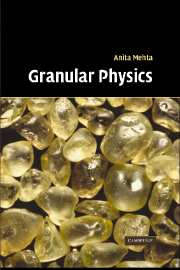Book contents
- Frontmatter
- Contents
- Preface
- 1 Introduction
- 2 Computer simulation approaches – an overview
- 3 Structure of vibrated powders – numerical results
- 4 Collective structures in sand – the phenomenon of bridging
- 5 On angles of repose: bistability and collapse
- 6 Compaction of disordered grains in the jamming limit: sand on random graphs
- 7 Shaking a box of sand I – a simple lattice model
- 8 Shaking a box of sand II – at the jamming limit, when shape matters!
- 9 Avalanches with reorganising grains
- 10 From earthquakes to sandpiles – stick–slip motion
- 11 Coupled continuum equations: the dynamics of sandpile surfaces
- 12 Theory of rapid granular flows
- 13 The thermodynamics of granular materials
- 14 Static properties of granular materials
- References
- Index
- Plate section
9 - Avalanches with reorganising grains
Published online by Cambridge University Press: 06 October 2009
- Frontmatter
- Contents
- Preface
- 1 Introduction
- 2 Computer simulation approaches – an overview
- 3 Structure of vibrated powders – numerical results
- 4 Collective structures in sand – the phenomenon of bridging
- 5 On angles of repose: bistability and collapse
- 6 Compaction of disordered grains in the jamming limit: sand on random graphs
- 7 Shaking a box of sand I – a simple lattice model
- 8 Shaking a box of sand II – at the jamming limit, when shape matters!
- 9 Avalanches with reorganising grains
- 10 From earthquakes to sandpiles – stick–slip motion
- 11 Coupled continuum equations: the dynamics of sandpile surfaces
- 12 Theory of rapid granular flows
- 13 The thermodynamics of granular materials
- 14 Static properties of granular materials
- References
- Index
- Plate section
Summary
When grains are deposited on a sandpile, avalanches result. These have much in common with many other varieties of avalanche; for example, snow or rocks, or even the stress releases that result in earthquakes. The unifying phenomenon in all these cases is that of a threshold instability: an overburden builds up, typically that due to surface roughening, to the point where this threshold is crossed, and grains are released in an avalanche. Avalanches can be classed in two main categories; those that do not have intrinsic time or length scales, and those that do. Avalanches relevant to granular media belong to the second category, and we shall discuss their characteristics in depth. We will, however summarise some of the known characteristics of the first category, referring readers who are interested in more details to ref. on the subject.
Avalanches type I – SOC
Bak, Tang and Wiesenfeld, in their now famous theory of self-organised criticality (SOC), suggested that extended systems were marginally stable, such that the slightest overburdening would cause avalanching; a sandpile at its so-called ‘critical’ angle of repose was held to be paradigmatic of this. Although this turned out to be, in retrospect, the wrong paradigm, the explorations that surrounded it in fact greatly enriched the physics of granular avalanches. We touch briefly on the important features of SOC here.
- Type
- Chapter
- Information
- Granular Physics , pp. 115 - 131Publisher: Cambridge University PressPrint publication year: 2007



